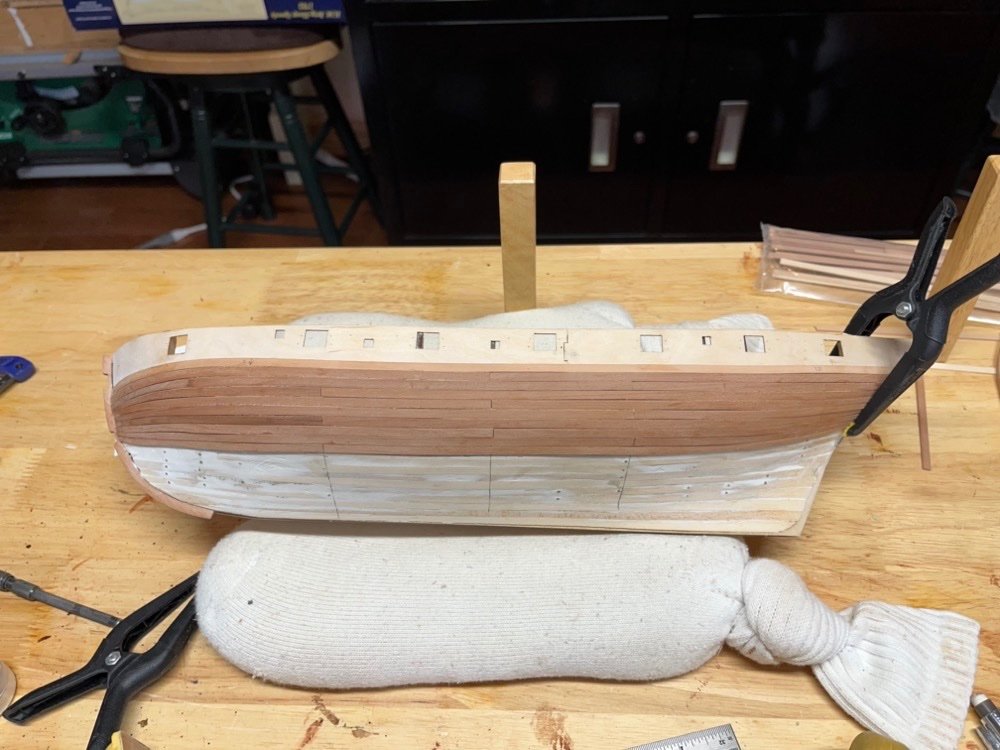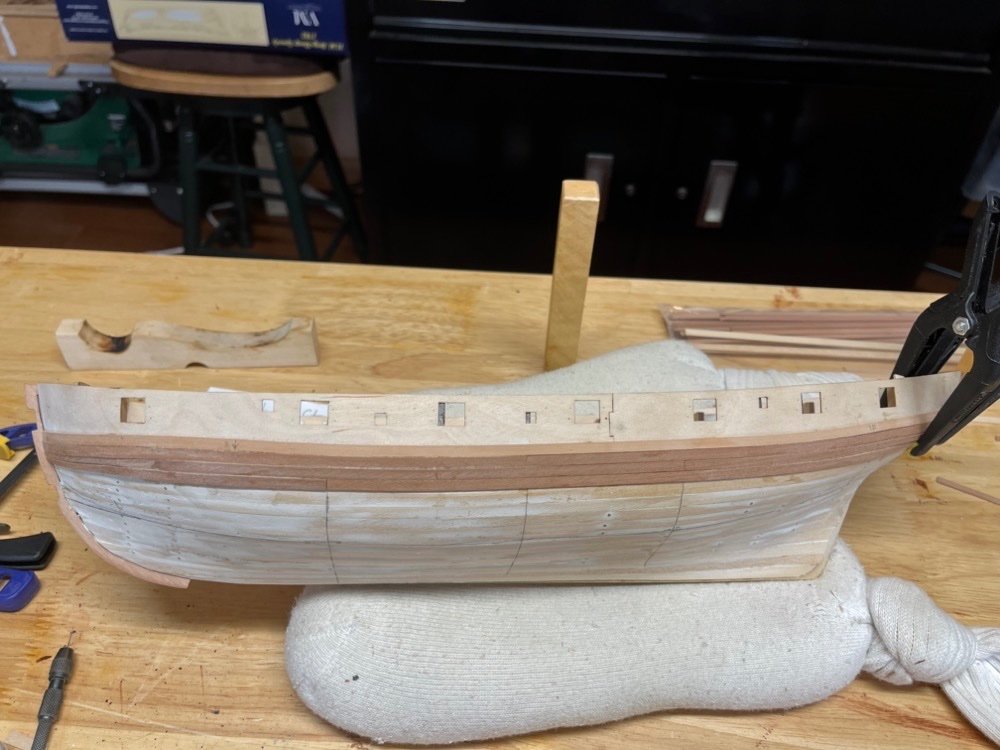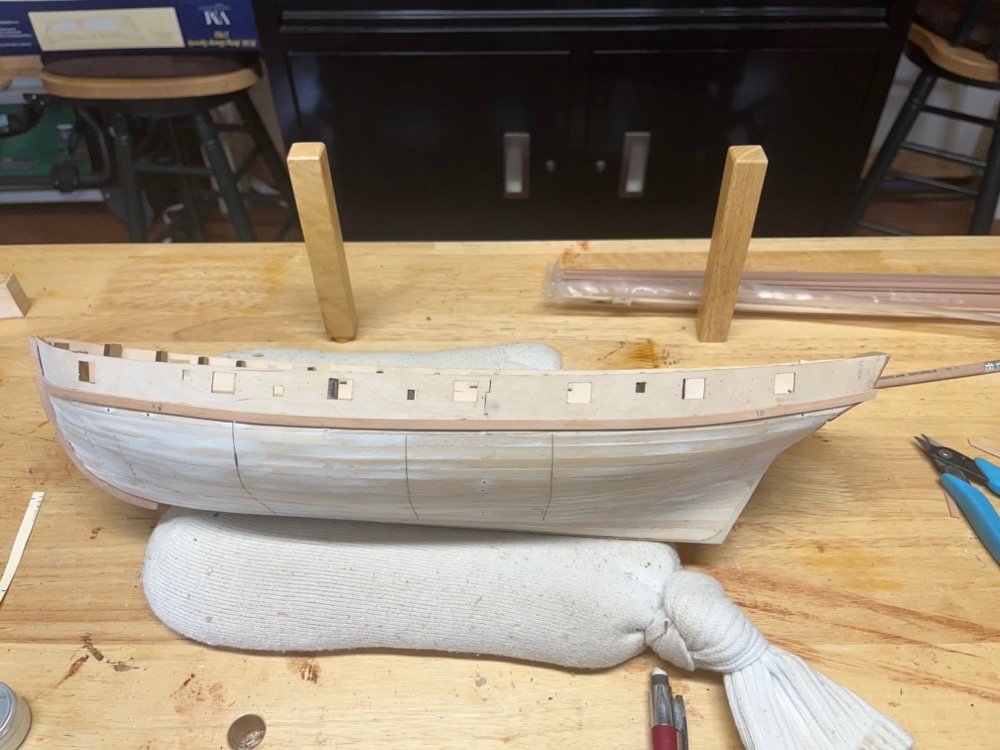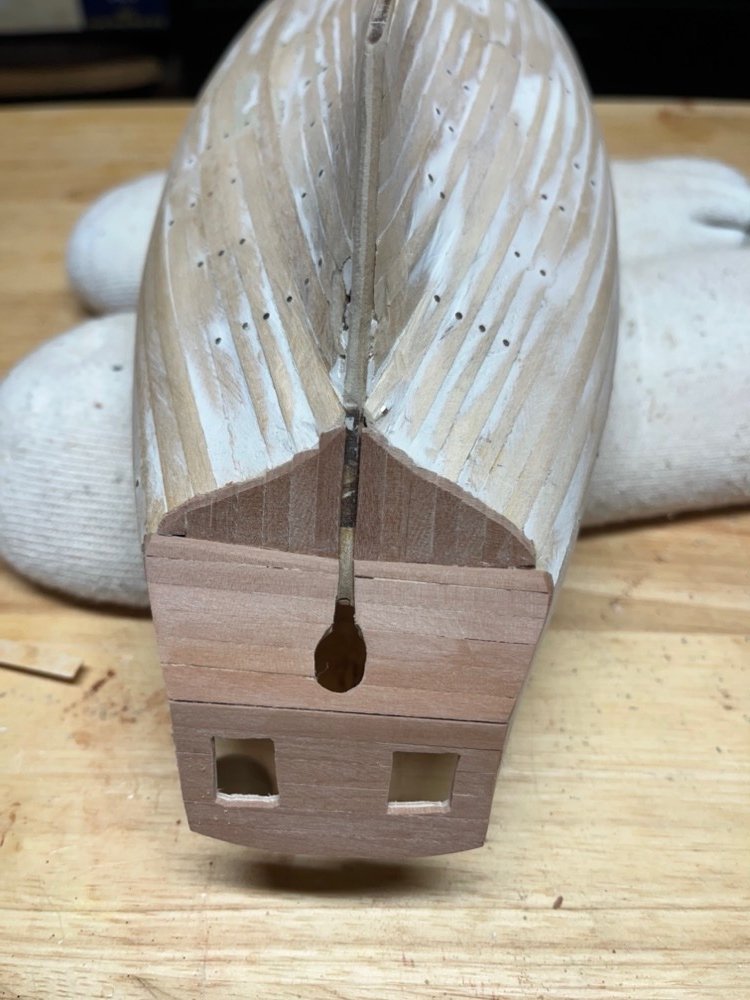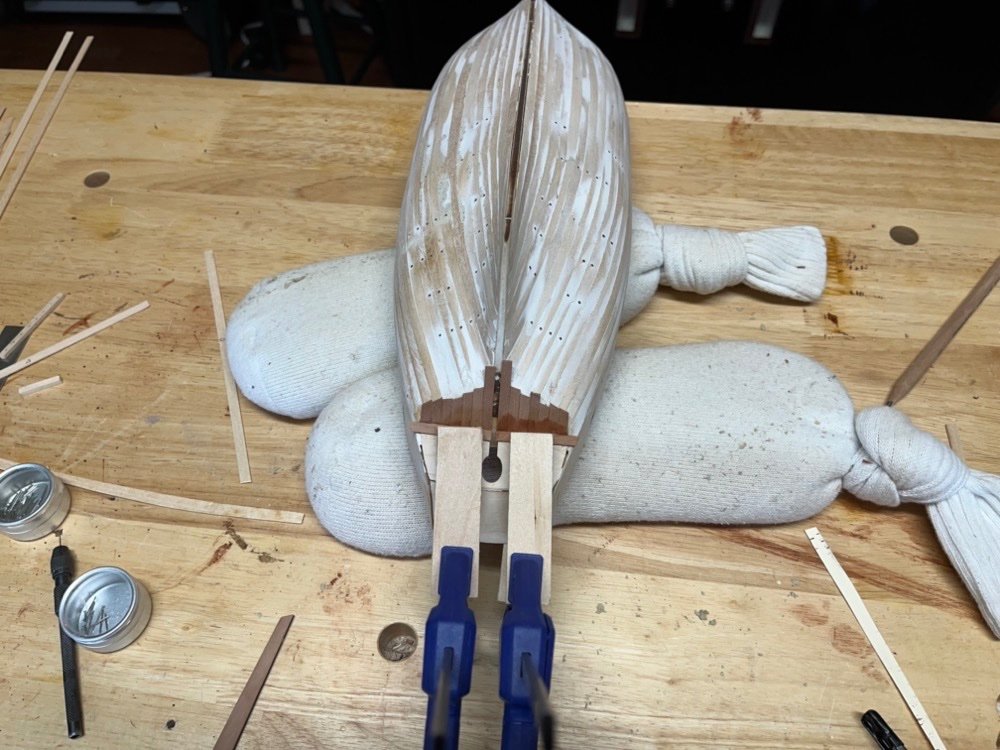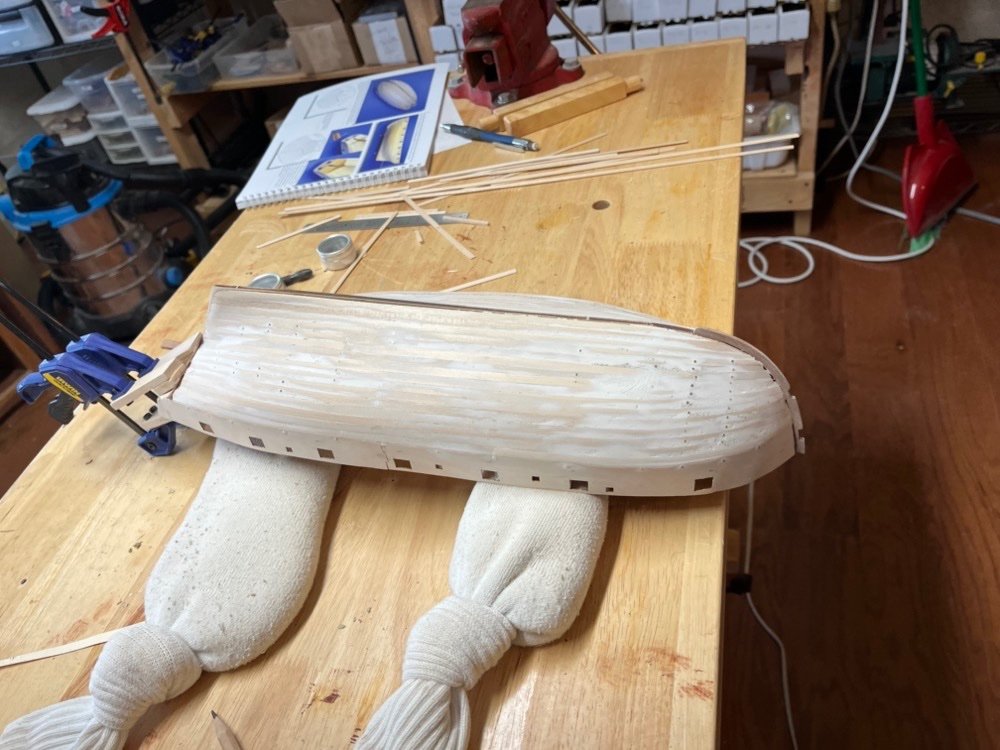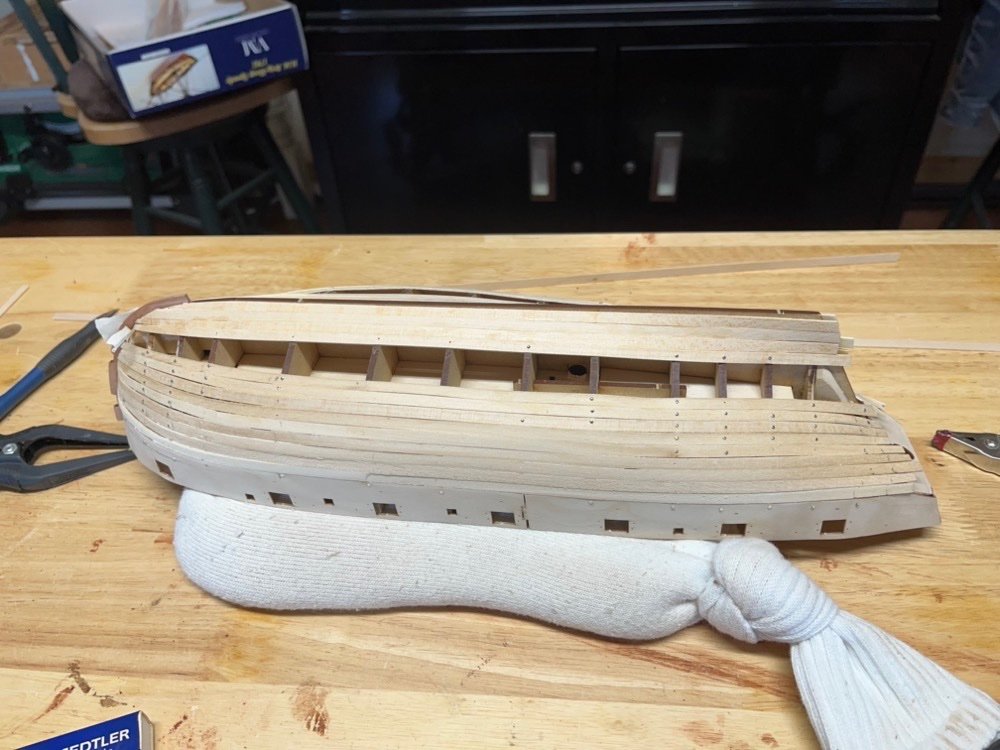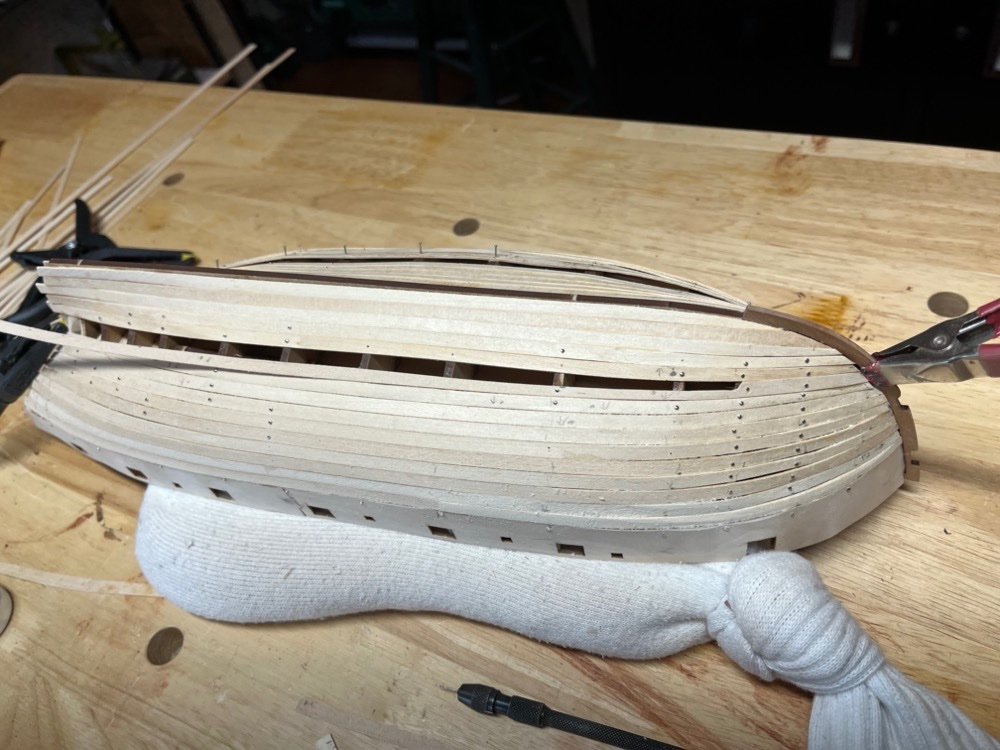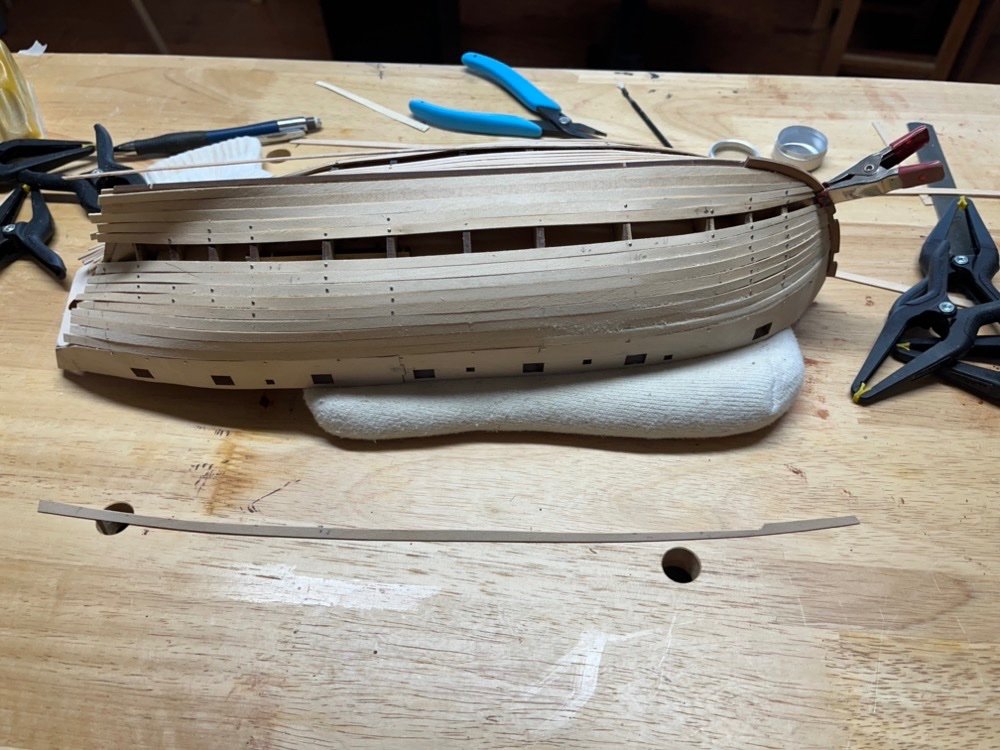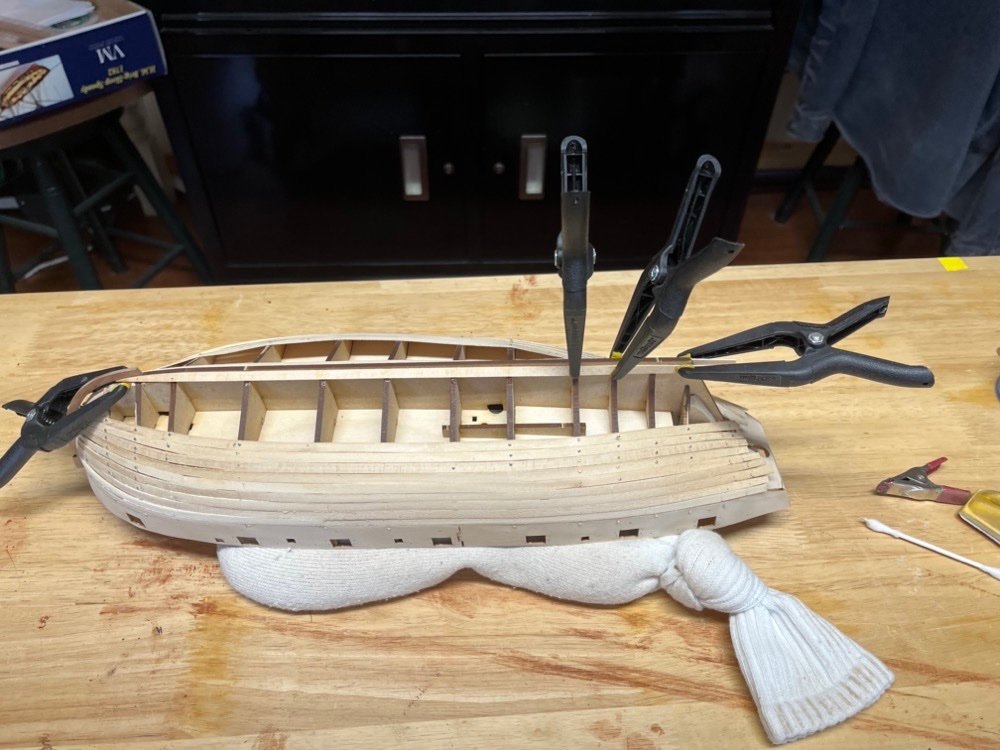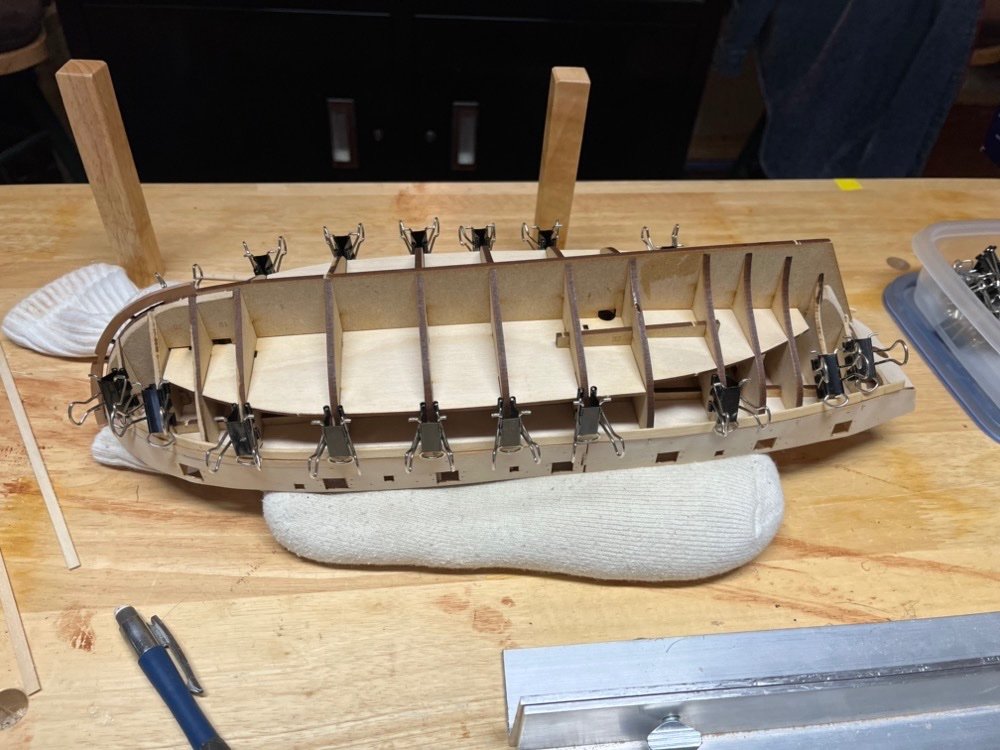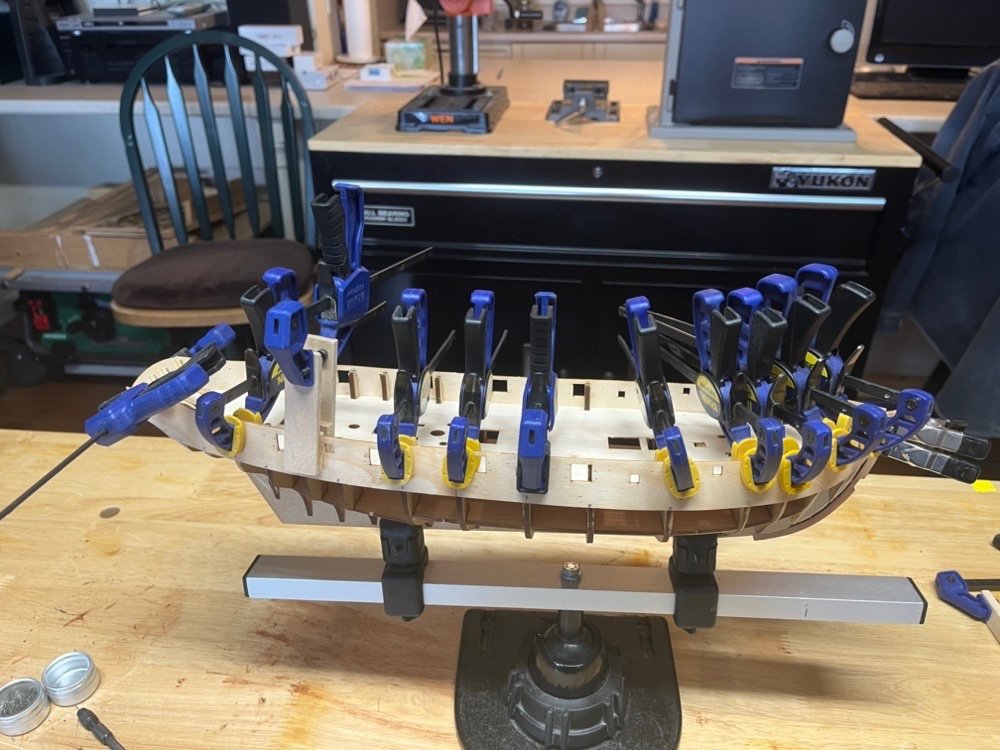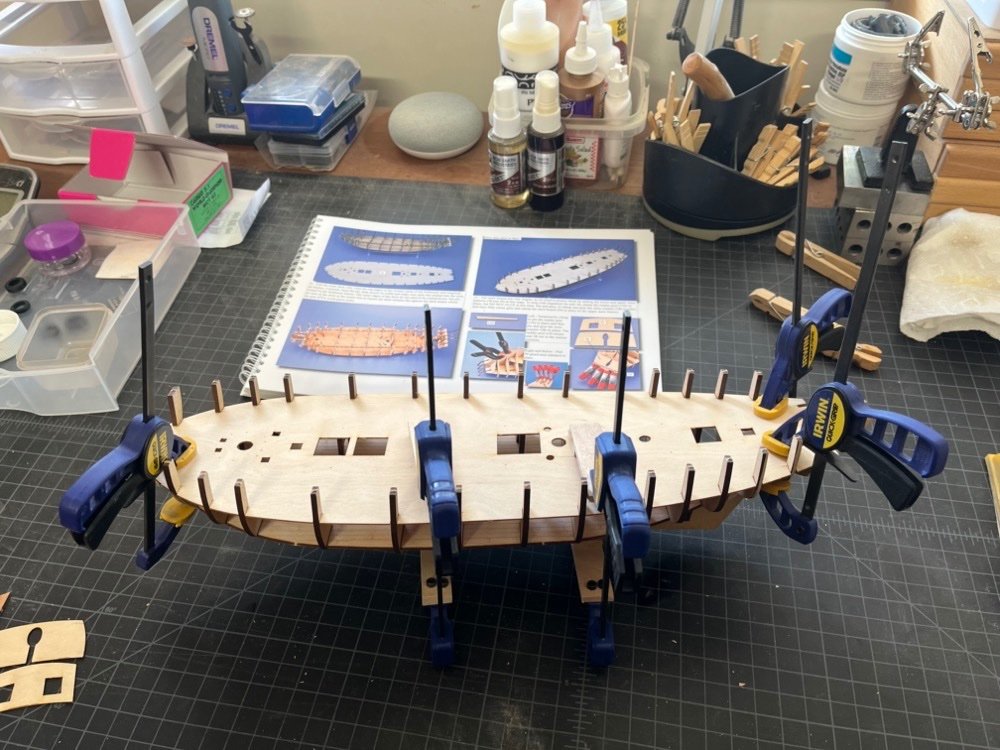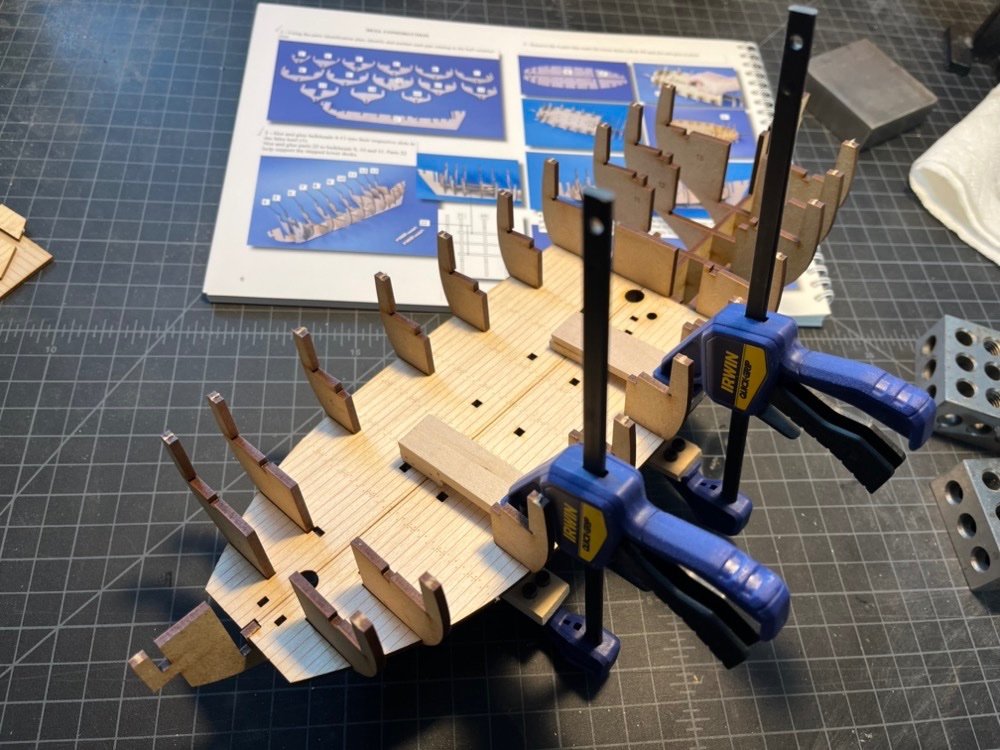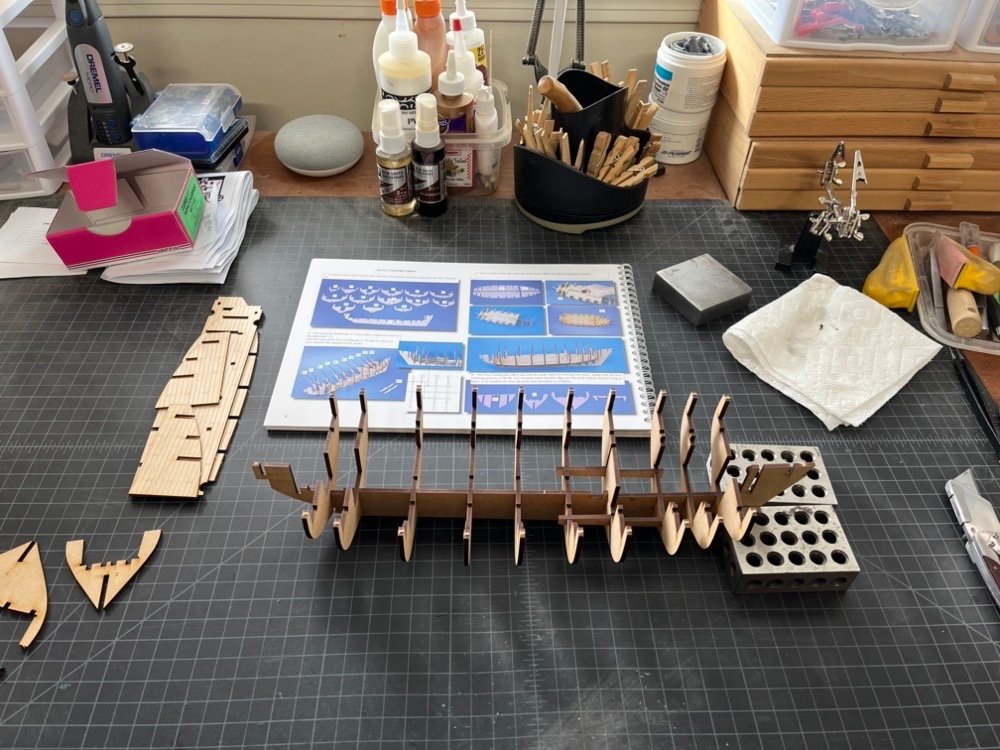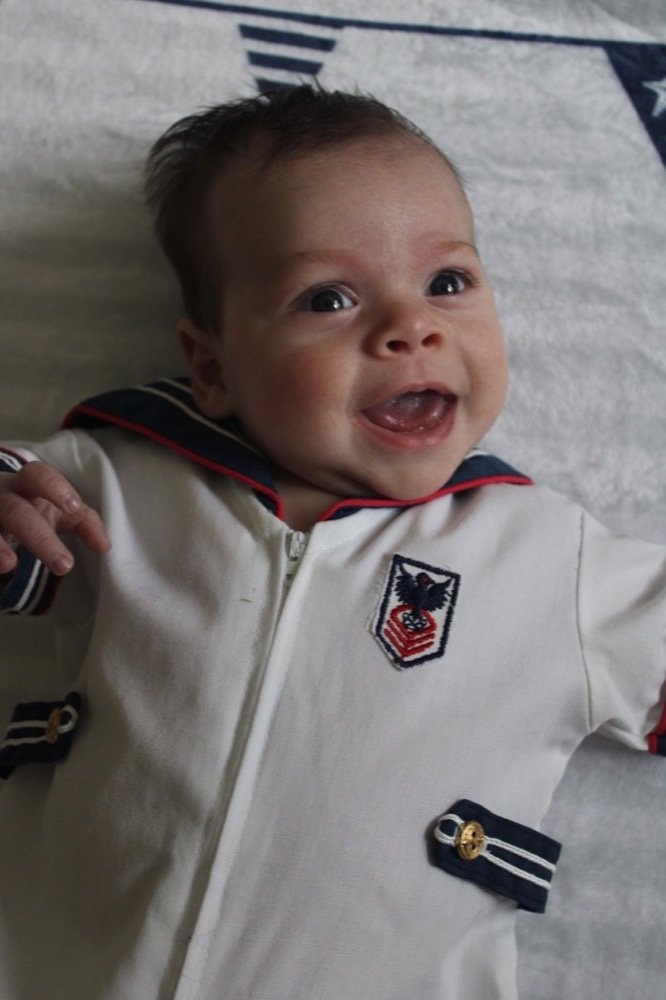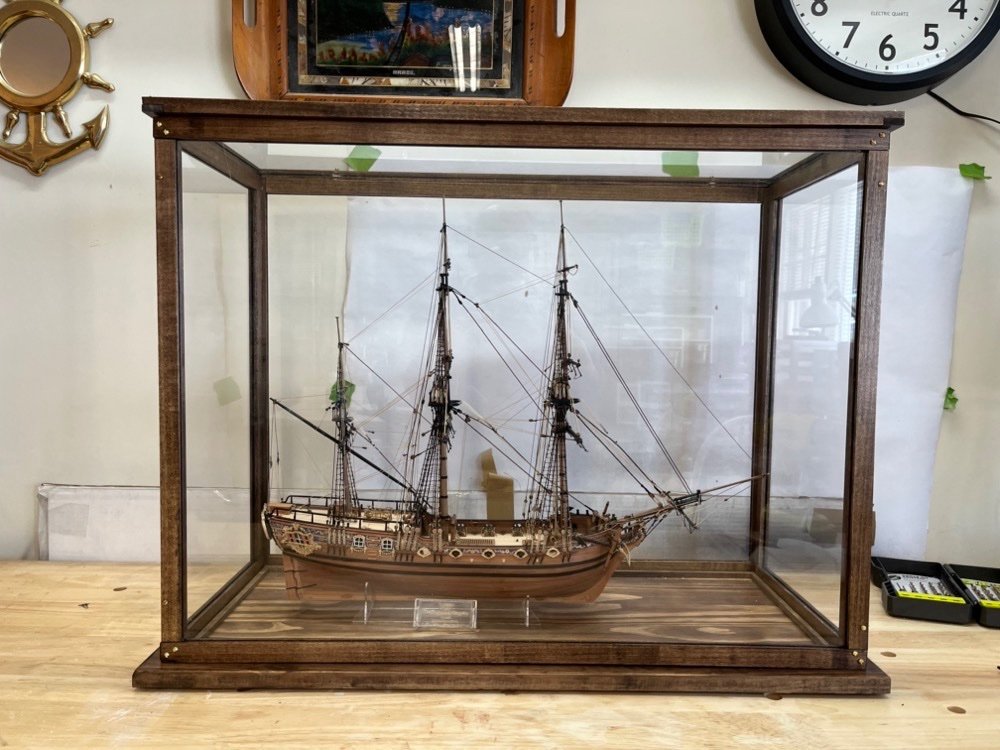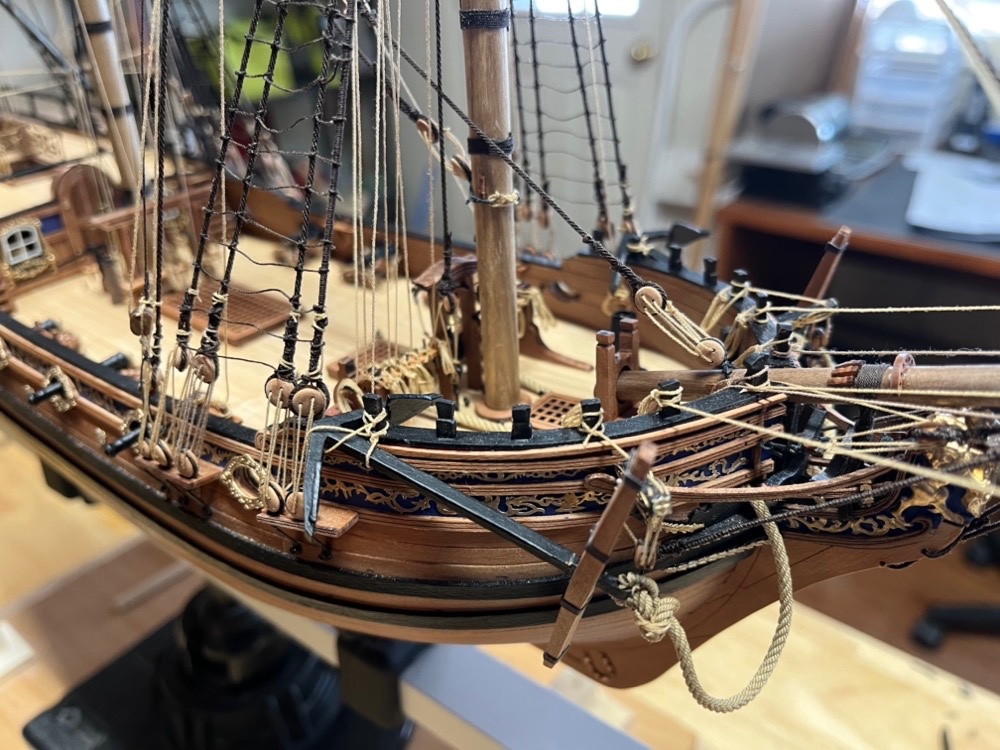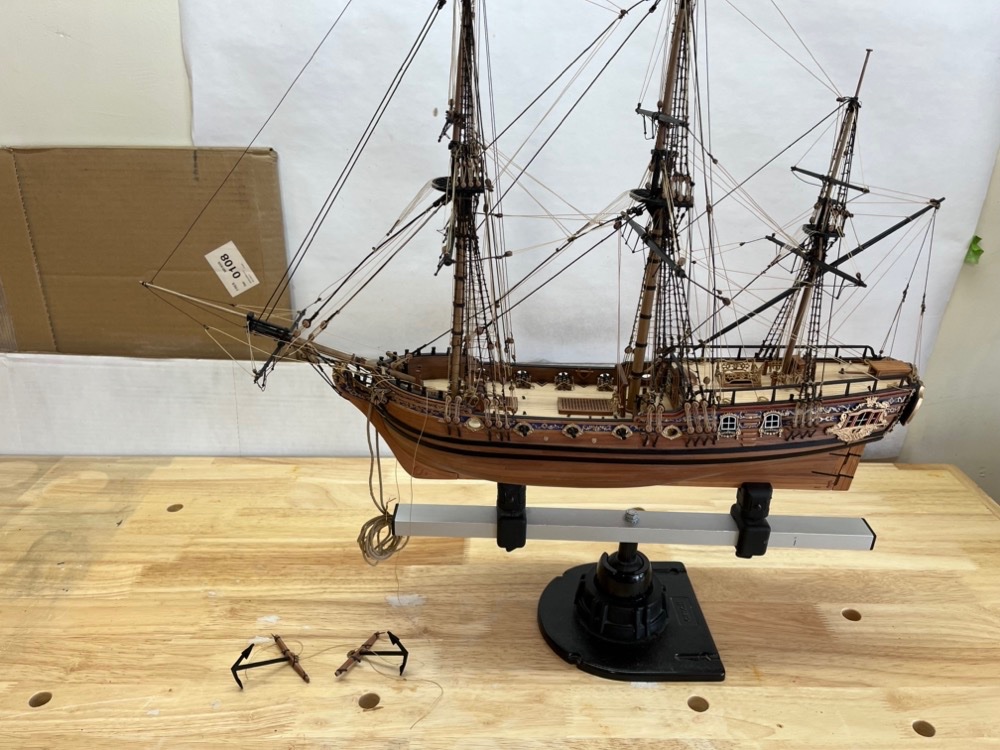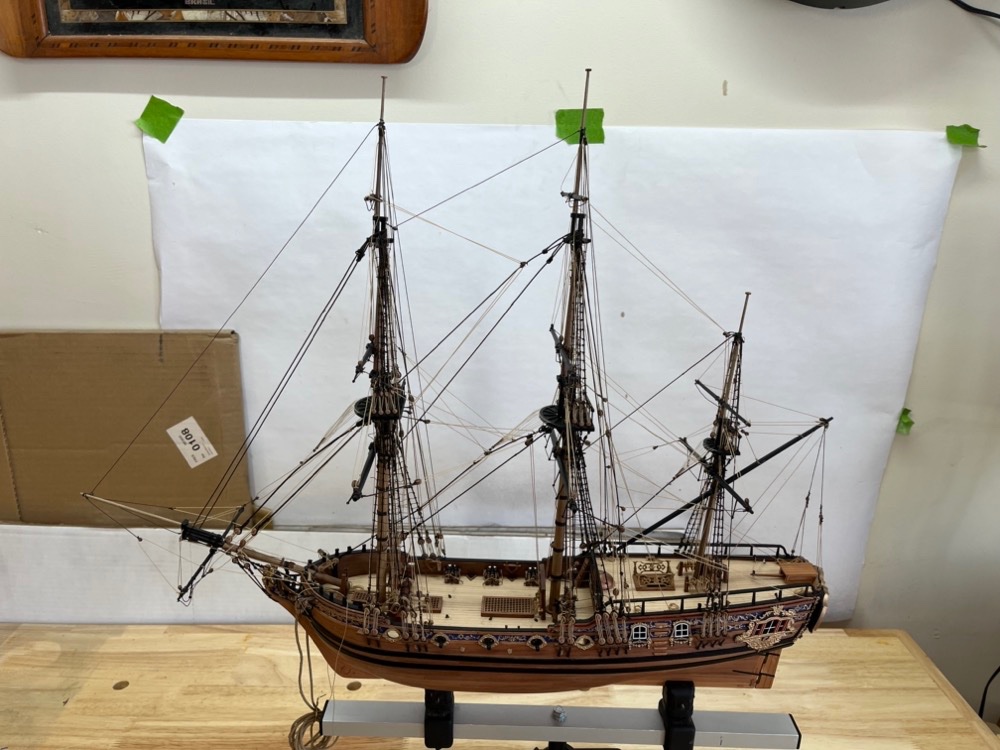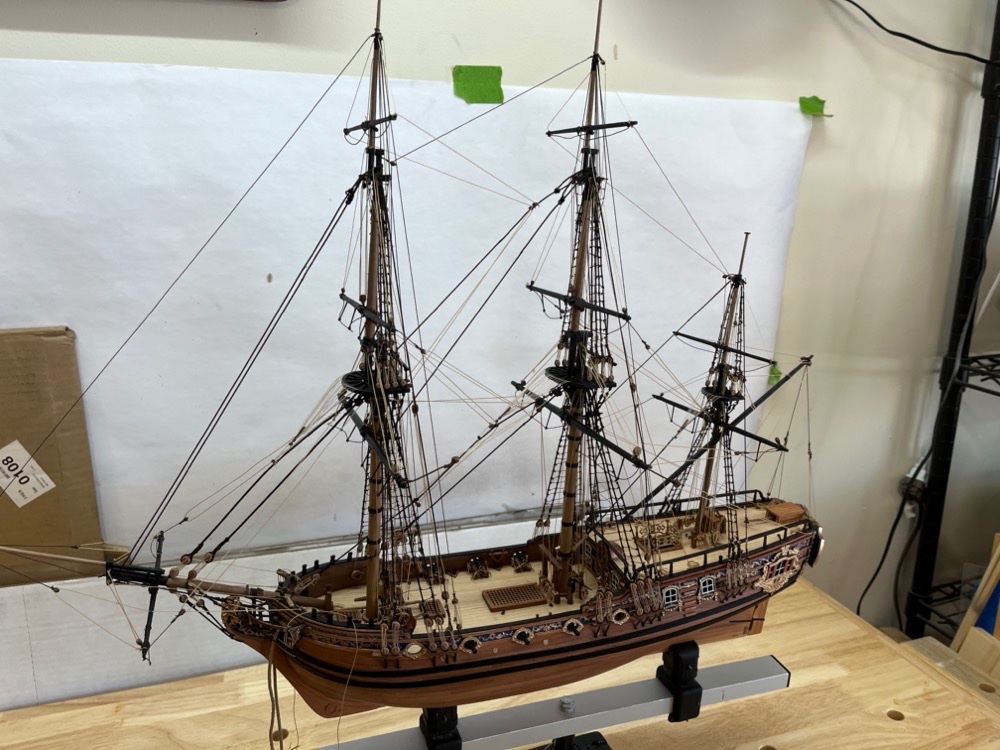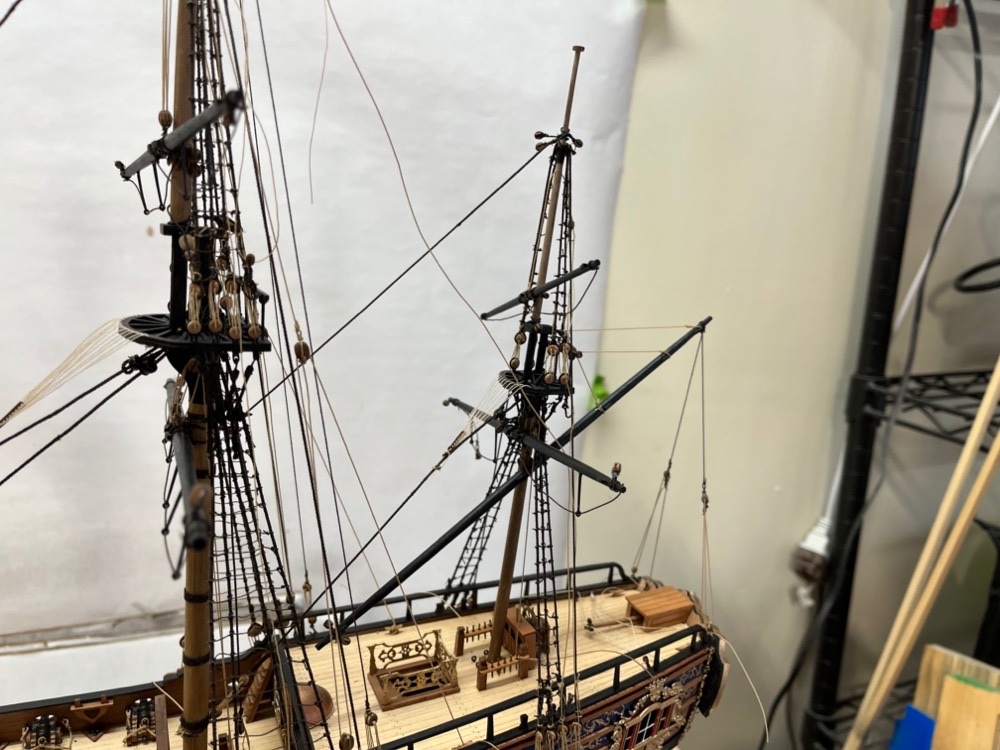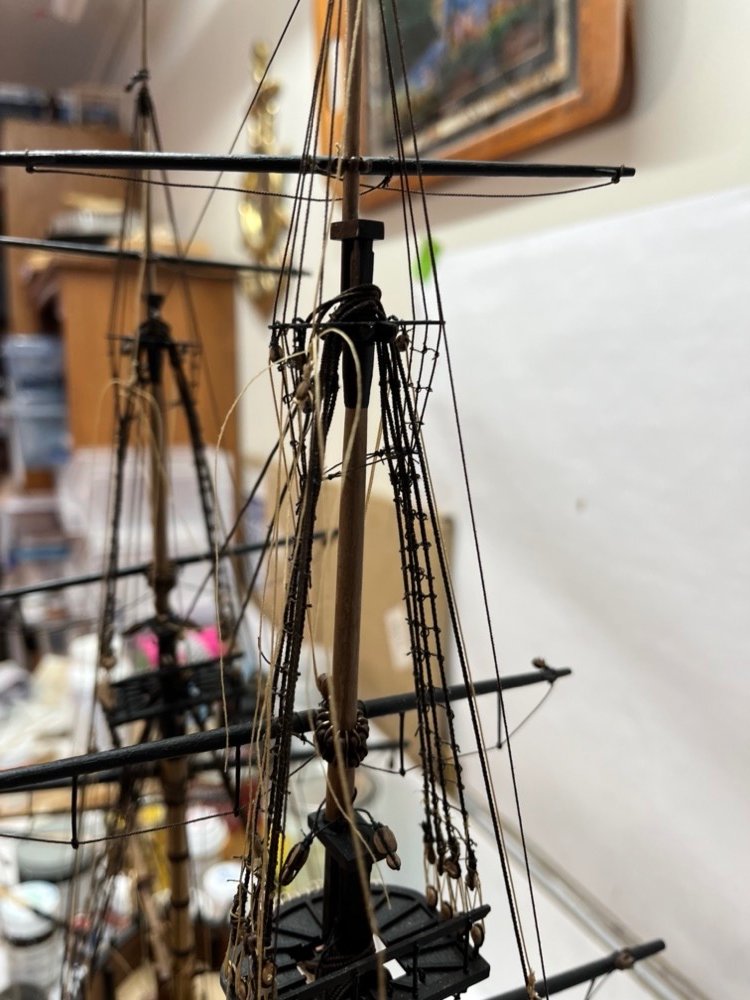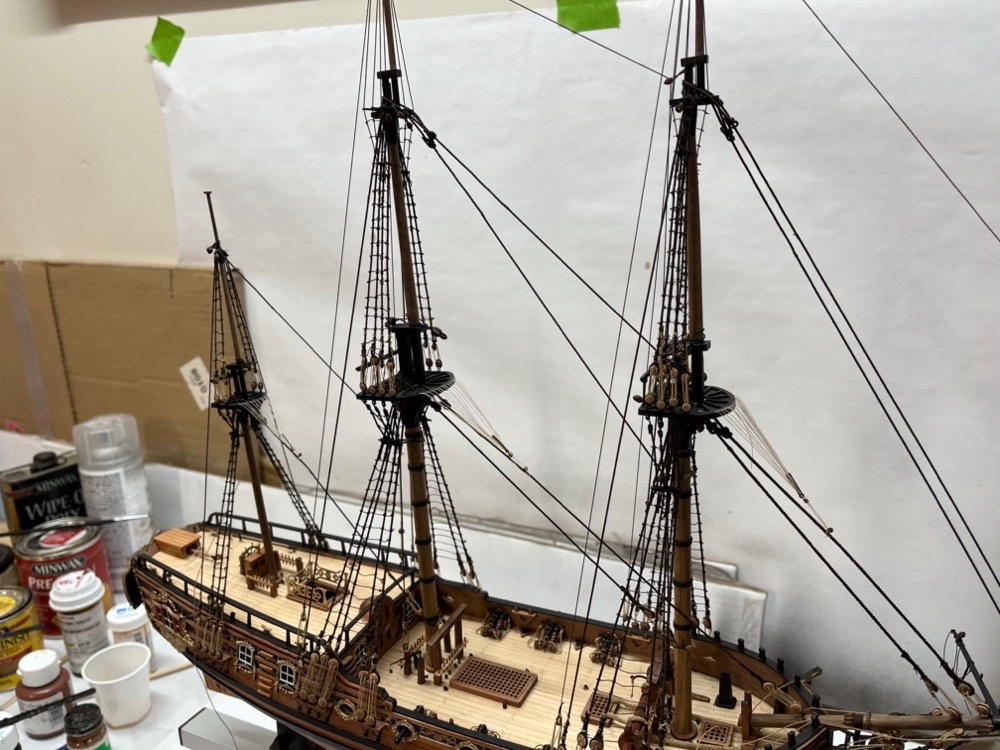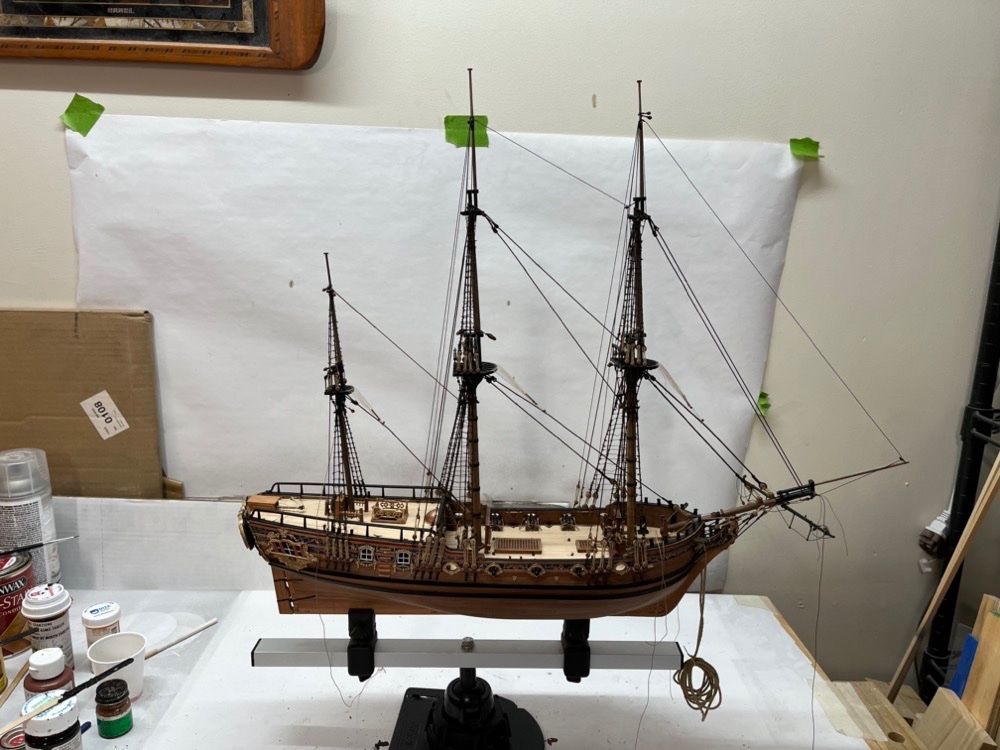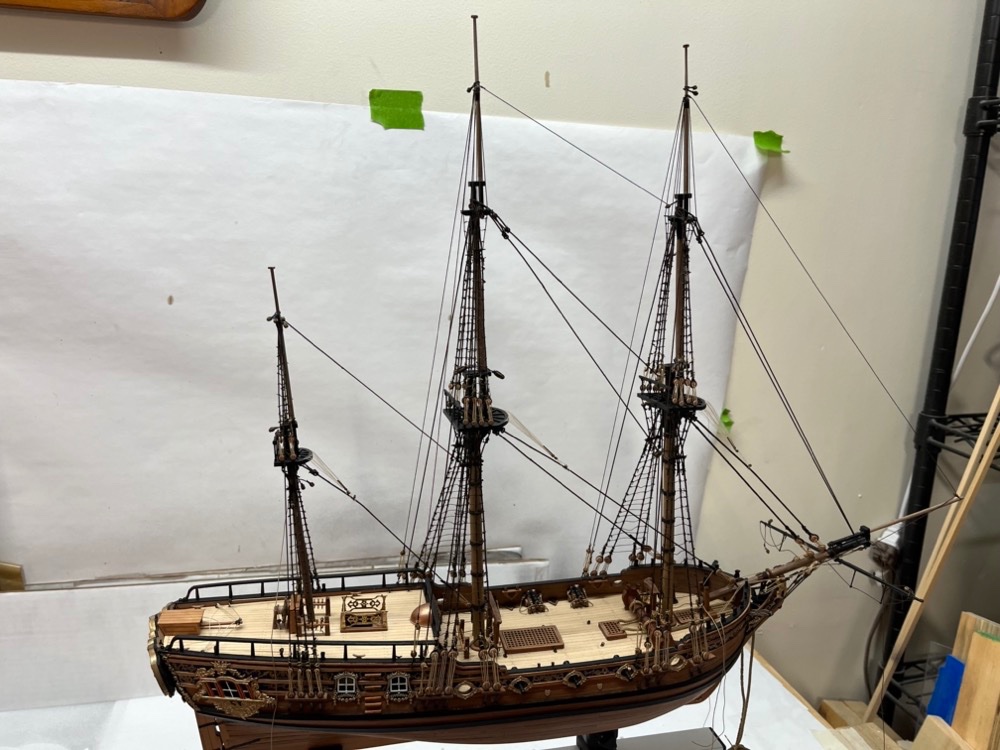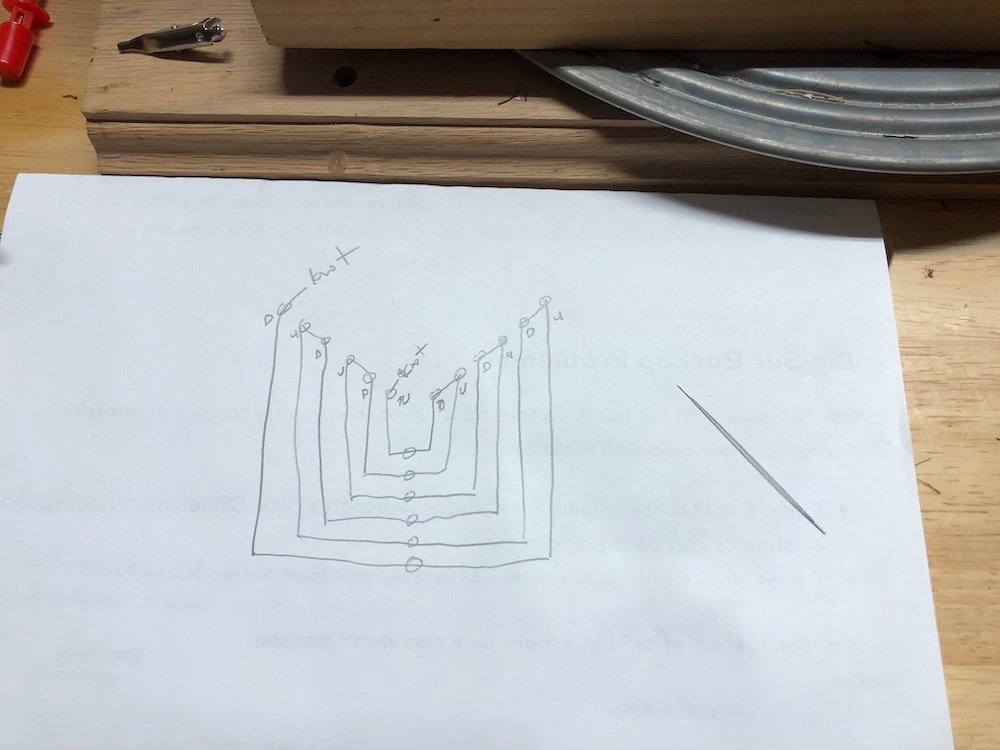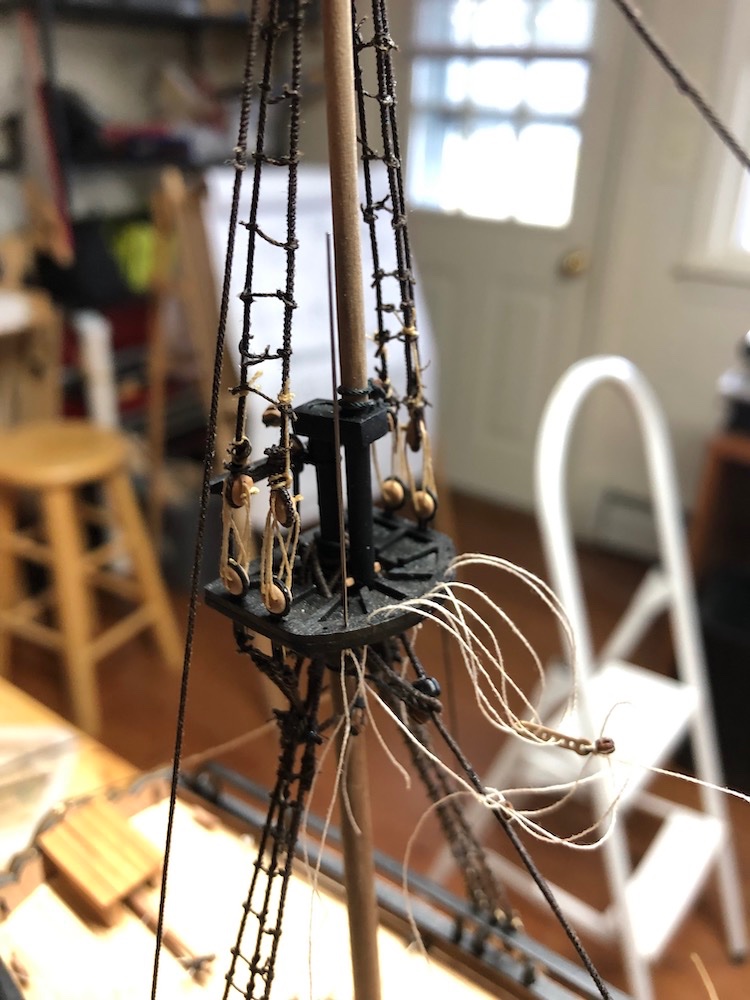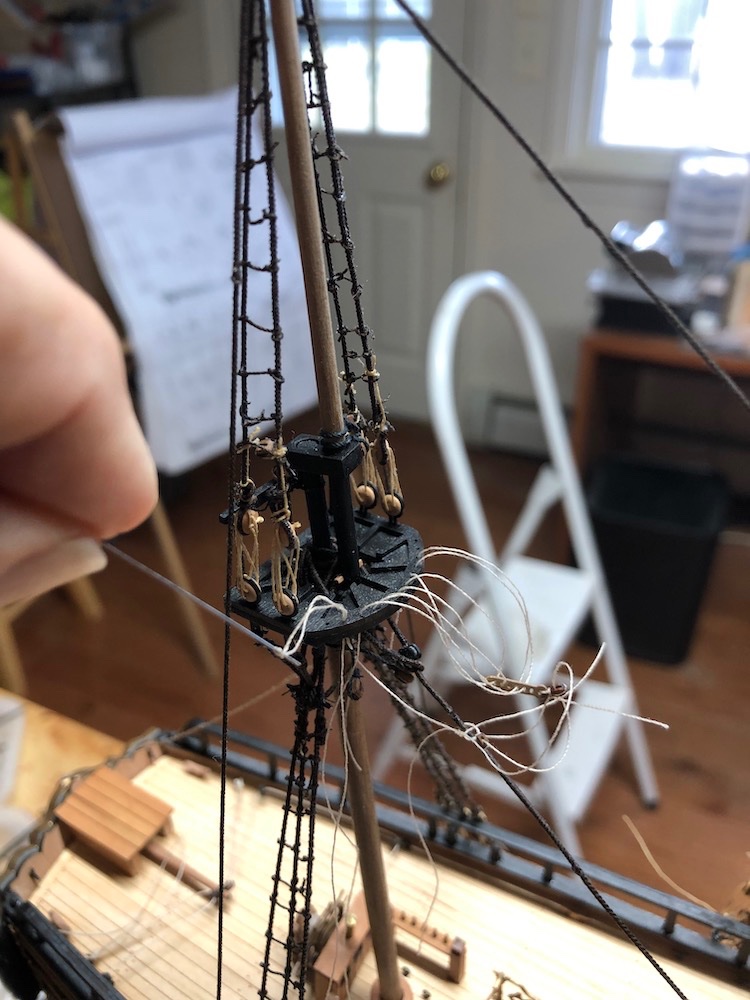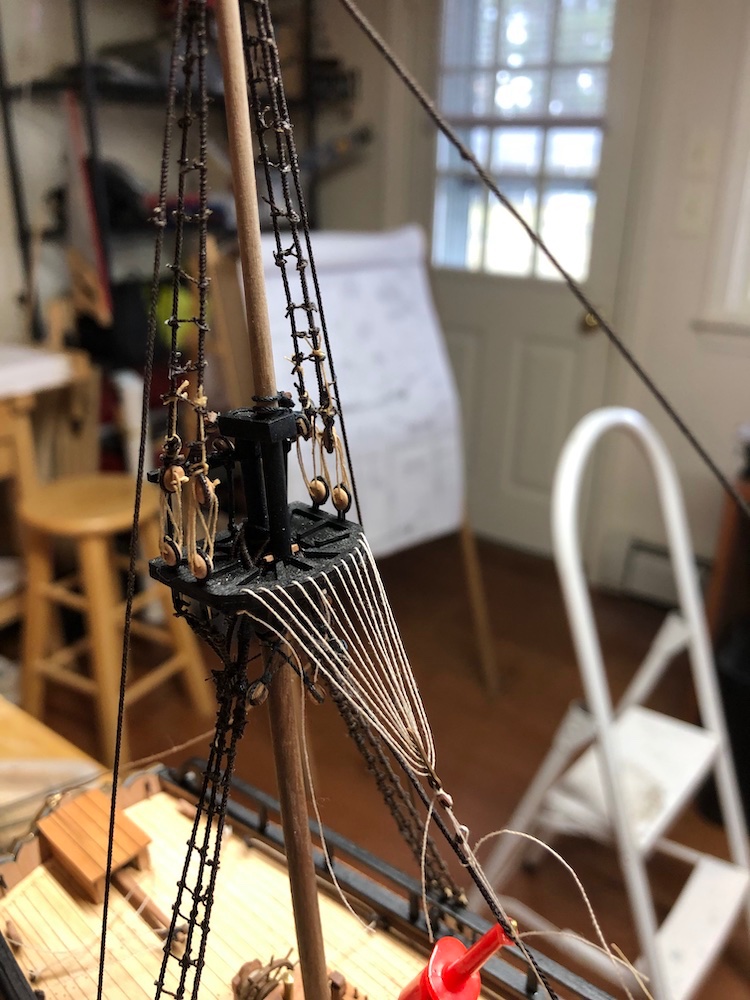-
Posts
2,269 -
Joined
-
Last visited
Content Type
Profiles
Forums
Gallery
Events
Everything posted by usedtosail
-
Thanks Sjors. I would be happy to answer any questions you have. It has been a few years since I built this model but I took good notes as I built it. Thank you too Der Alte. Take your time and don't be afraid to do something over again if you are not happy with it. Also I found the first chapter of Robert Hunt's practicum, which you can get for free, helpful to get started but I didn't buy any of the other chapters. There is a lot of useful information in the build logs on this site as you have found and most of the builders that wrote them are still active on the site. And the most important thing is to start a build log as that is the best way to get advice when you need it, I have found.
- 1,348 replies
-
- constitution
- model shipways
-
(and 1 more)
Tagged with:
-
Here are the first four planks on the port side. I have started tapering them at the bow and stern. I measured down 10 planks in the middle section, then used a batten to extend the line to the bow and stern. I only had to taper about the first inch and a half at the bow and inch at the stern. These pear planks take to @Chuck's edge bending technique really well, using only a small iron.
-
I planked the whole counter and transom with the pear strips. I used vertical planks for the lowest section, but deviated from the instructions and used horizontal planks for the upper transom as well as the counter. Mostly this was an aesthetic issue for me but also it made this task a little easier. I used small files to clean up the excess plank lengths in the gun ports and rudder opening, and a Dremel with a sanding disk, files, and sanding block to sand the excess plank ends to be flush with the first planking. I also filed the back edge of the keel piece down to 1.5mm so the second planks with fit somewhat flush with the stern post. At this point I am ready to start the second planking of the hull. I started marking off the hull for these planks which are 1 mm thinner than the first planking. I'll figure out the tapers at the bow and maybe the stern before I start. I also marked three bulkheads to use for a 3 butt shift as I will not be using full length planks for the second planking.
-
I have completed the first planking. I filled the low spots with diluted wood putty then sanded everything smooth, then did that two more times to fill any remaining low spots. I used a Dremel to cut and sand down the ends of the planks at the transom. I also filed down the nail heads but left them in place. I think it came out OK for a first planking but the second planking has to be a lot better. I then used the second planking strips, which are pear, to start planking the transom. These strips need to be cut and sanded flush with the first planks before I can start adding the second planks over the first.
-
Thanks Thukydides. I planked part of the way up from the garboard strakes until I had a gap of about three planks left. At this point I was again having to bend the planks a lot, so I decide I would add a drop plank in this gap. I added one more full length plank then the drop plank. You can see one on the bench in the next image. It still has a good bend through most of the length but fit pretty well. And here it is being installed. I have since cut the planks to fill the remaining gap on each side and am in the process of gluing them in place. I have also started filling in the low spots on all the planks with wood putty and will start sanding the hull when that is completed. Not the prettiest planking job but OK for the first layer. This will all be covered with the second layer, which will be pear. The pear strips are not as wide as these planks so I am not sure if they will be easier to bend and fit. I hope they will be but we shall find out soon enough.
-
I put about half the planks from the gun ports down, but then I decided to add the garboard strakes and plank up to what I had already done. Here are the garboard strakes being glued in place. I first glued the planks to the middle bulkheads using medium CA glue since I couldn't plank them to anything. I then glued the fore and aft ends to those bulkheads, which I was able to clamp.
-
The gun port pieces came out pretty well but there were two issues. At the transom the gun port pieces were pinched in between the last bulkhead and the transom. I determined that I had not sanded the transom piece enough so it was causing the ends of the gun port pieces to be out too far. I carefully released the glue joints between them and the transom pieces, then used a Dremel sanding disk to reduce the width of the upper transom piece. When I re-glued the gun port pieces to the transom piece, I also put a spacer between them to push them outward a bit. When the glue dried the gunk port pieces came out much straighter. I am also not worried about that joint, as medium CA seems to hold it very well. The other problem I had was that at the bow the bottoms of the gun port pieces were a little too far away from the first 5 or so bulkheads. The planking strips provided for the first planking are pretty thin so I was worried that I would sand through them getting them flush with the bottom of the gun port pieces. My solution was to use a thicker planking strip for the bow area of the first plank below the gun port pieces. This should give me enough meat to sand without getting too thin. I can also use wood filler in this area if I need to to fill in any gaps that might show up. So the first planking has started. I measured each bulkhead using a tick strip to determine the number and width of the planks at each bulkhead. The planks need some tapering at the first 5 bulkheads at the bow and at the last bulkhead and transom at the stern. I tapered two thicker strips for the first plank at the bow and two regular width strips for the rest of the first plank, soaked them for just a few minutes, used a plank bender to bend in curve at the bow, then clamped them to the bulkheads to dry. Once they are dry I will glue and clamp them in place. One plank down, many more to go.
-
After adding the transom pieces, it was time to fair the bulkheads, add the stem piece, then add the gun port pieces. The gun port pieces had to be soaked then bent to the bulkheads. As per the instructions, I pinned the bottoms and clamped the tops to the bulkheads, let them dry overnight, then glued and pinned them back into place. I did the port side pieces first, and I now have the starboard pieces soaked and drying. I am worried about where the aft gun port pieces are glued to the transom pieces, as this is a very thin gluing area and I don't see anything coming up that will help hold these joints. I did use medium CA to hold these joints which should help.
-
Thanks Eric and the likes. I continue putting the frame together and this was the trickiest part - adding the base for the upper deck. It has to be bent just enough to get between the frames and those very fragile transom supports. I managed to get it in place and glued to the bulwarks and used some clamps to hold the middle of the deck sown while it dries. The next step is to add those transom pieces, to protect those transom supports.
-
I have been using Dullcoat Lacquer on the Mara polyester ropes I make for the past 5 years with good results.
-
This will be my second Vanguard kit. I have wanted to build this ship model ever since it was released. I will be building it for our new first grandson, Thomas Joseph. His nursery is a nautical theme so the completed model will go in there when he is older. I have to include a picture of the little guy. The sailer suit was actually his father's, our son, from when he was a baby. Ok enough of that. I have unboxed the kit and started cutting out the bulkheads and keel. Pictures of the actual model coming soon.
-
Thanks Derek. Your Duchess is beautiful. One last picture of the Duchess in its new case, which I finished today. I will be delivering it to my friends later this week.
- 118 replies
-
- Duchess Of Kingston
- Finished
-
(and 1 more)
Tagged with:
-
That is a very nice build KH! You should be very proud of your efforts. I am sure you will be able to make a nice mahogany cradle.
- 110 replies
-
- Bluejacket Shipcrafters
- Constitution
-
(and 2 more)
Tagged with:
-
Your model is amazing Derek. Such neat, precise work!
- 341 replies
-
- Duchess Of Kingston
- Vanguard Models
-
(and 1 more)
Tagged with:
-
Thank you Glenn, Bob, Dave and Gary, and for those that pressed the Like button. I really appreciate it. I am in the process of uploading better pictures of the completed Duchess to the gallery. Have a look there if you want to see more of the model.
- 118 replies
-
- Duchess Of Kingston
- Finished
-
(and 1 more)
Tagged with:
-
Thanks Glenn and the likes. I finished adding the anchors this morning. The model is now completed! I have to say I am really impressed with the work of @chris watton and Vanguard. This kit was my first Vanguard kit and it was so much fun to build without too many frustrations or headaches like other kits. The level of detail on these kits is amazing too. I will be making a case for the model and then delivering it to our friends Joanne and Paul, who just bought a house here on Newfound Lake. This is the second model I have given away to friends and I am so flattered that they want them in their homes. As it says in my signature, my next build will be the Vanguard Speedy. I have wanted to build this ship since the kit came out. I am building it for our first grandchild, Thomas Joseph (TJ), who was born at the end of January. His nursery is already a nautical theme so it will fit right in, but not until he is old enough, whenever that will be. I'll start a build log when I start the kit, probably around April or May. For now I need to clean up the workshop and take some glam shots of the Duchess. I'll post some here and in the gallery, probably next week sometime. Thanks for your interest in this build and happy building yourselves.
- 118 replies
-
- Duchess Of Kingston
- Finished
-
(and 1 more)
Tagged with:
-
Thank you Gary and for the likes. Here are some quick shots showing the completed rigging, except for the anchors. I finished adding the lifts then the braces, adding rope coils as I went along. I also tightened up and fixed the fore topG stay. The final steps are the anchors and the display stand. I am assembling the supplied anchors using black construction paper for the irons on the stocks. I wrapped the anchor rings with tan line and fixed the ends with some lacquer. I still need to trim the ends of the paper after the glue dries and tie the anchors to the lines I already installed on the model. I also added cat blocks to the cat heads, using a couple of left over double blocks, and will hook them onto the anchor rings. I will take better pictures when the model is completed, probably later this week.
- 118 replies
-
- Duchess Of Kingston
- Finished
-
(and 1 more)
Tagged with:
-
I now have all the yards attached to the masts with various parrels or slings. I replaced the black beads that came with the kit with brown seed beads that I had of roughly the same size. I am still in the process of running the ties for the topG yards down to the mast tops and deck. Without the lifts and braces attached the yards are not leveled yet. I have started rigging the lifts for the sprit sail yard and will be adding the lifts for all the yards next.
- 118 replies
-
- Duchess Of Kingston
- Finished
-
(and 1 more)
Tagged with:
-
Another milestone - the standing rigging is completed (almost). I left the fore topG stay loose for now in case I snag it (again) while adding the running rigging. Now its on to the running rigging, starting with adding the yards to the masts.
- 118 replies
-
- Duchess Of Kingston
- Finished
-
(and 1 more)
Tagged with:
-
Standing rigging of the main and fore top Gallant shrouds and stays continues. I added the topmast catharpins then the topG shrouds. I then added the main and fore topmast stays. I am currently tying the ratlines to the fore and main topmast shrouds, then I'll add them to the topG shrouds. I also added the mizzen crows feet. I am using the supplied 0.1mm thread for these. The first thing I had to figure out was how to thread these when the top has an even number of holes (it is supposed to have an odd number and the line is supposed to start at the euphroe). I sketched it out on paper and it took a few tries to get it, but then I used the sketch as a guide. Threading these requires running the line down through the mast top but also up from underneath. I found it impossible to thread the line from underneath even with CA on the line. Not being able to see the hole just made the end go limp after a few tries. So I tried using an eyeless needle, shown in the above image on the right, and it worked a treat. Here is how the crows feet came out. I have the blocks just tied off to the stay for now but I am pleased with the result so far.
- 118 replies
-
- Duchess Of Kingston
- Finished
-
(and 1 more)
Tagged with:
About us
Modelshipworld - Advancing Ship Modeling through Research
SSL Secured
Your security is important for us so this Website is SSL-Secured
NRG Mailing Address
Nautical Research Guild
237 South Lincoln Street
Westmont IL, 60559-1917
Model Ship World ® and the MSW logo are Registered Trademarks, and belong to the Nautical Research Guild (United States Patent and Trademark Office: No. 6,929,264 & No. 6,929,274, registered Dec. 20, 2022)
Helpful Links
About the NRG
If you enjoy building ship models that are historically accurate as well as beautiful, then The Nautical Research Guild (NRG) is just right for you.
The Guild is a non-profit educational organization whose mission is to “Advance Ship Modeling Through Research”. We provide support to our members in their efforts to raise the quality of their model ships.
The Nautical Research Guild has published our world-renowned quarterly magazine, The Nautical Research Journal, since 1955. The pages of the Journal are full of articles by accomplished ship modelers who show you how they create those exquisite details on their models, and by maritime historians who show you the correct details to build. The Journal is available in both print and digital editions. Go to the NRG web site (www.thenrg.org) to download a complimentary digital copy of the Journal. The NRG also publishes plan sets, books and compilations of back issues of the Journal and the former Ships in Scale and Model Ship Builder magazines.




